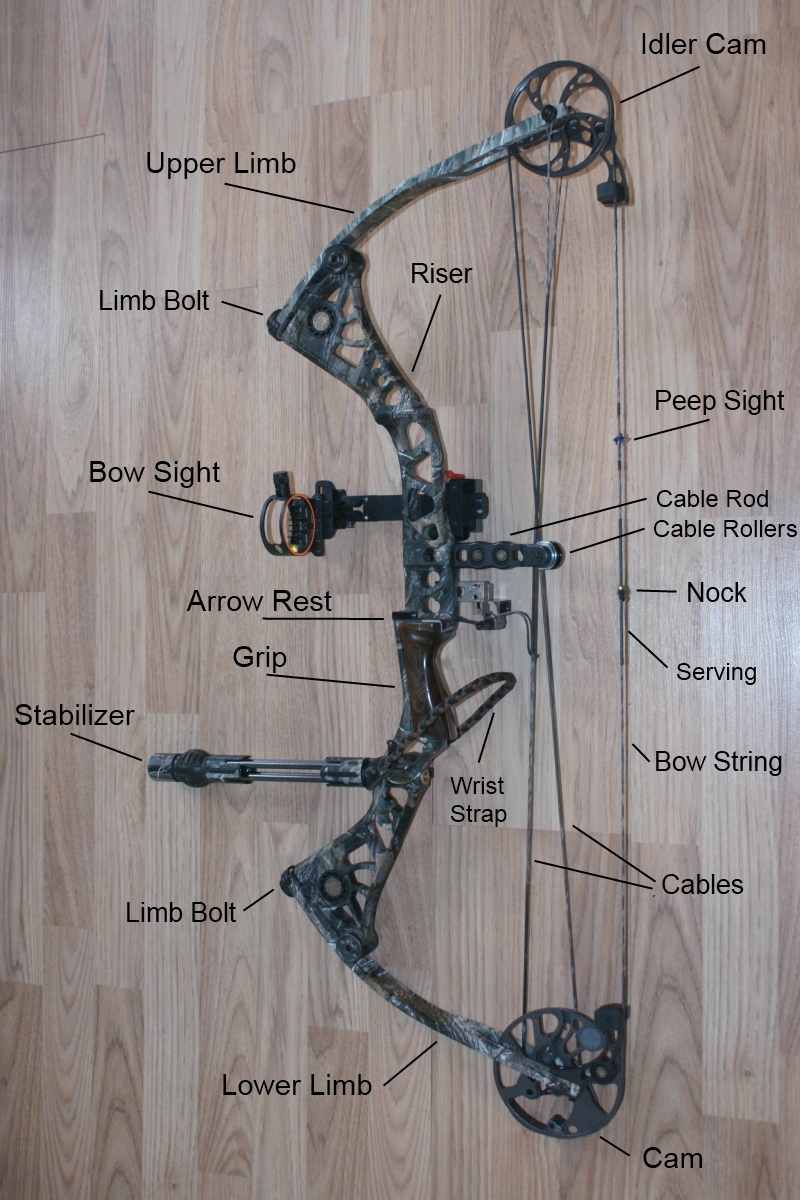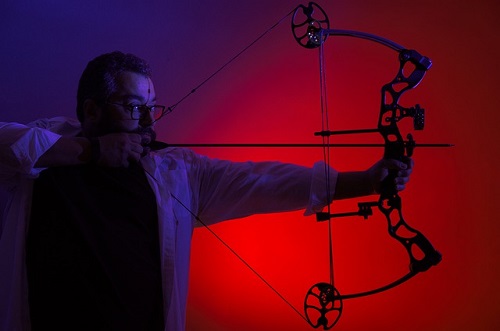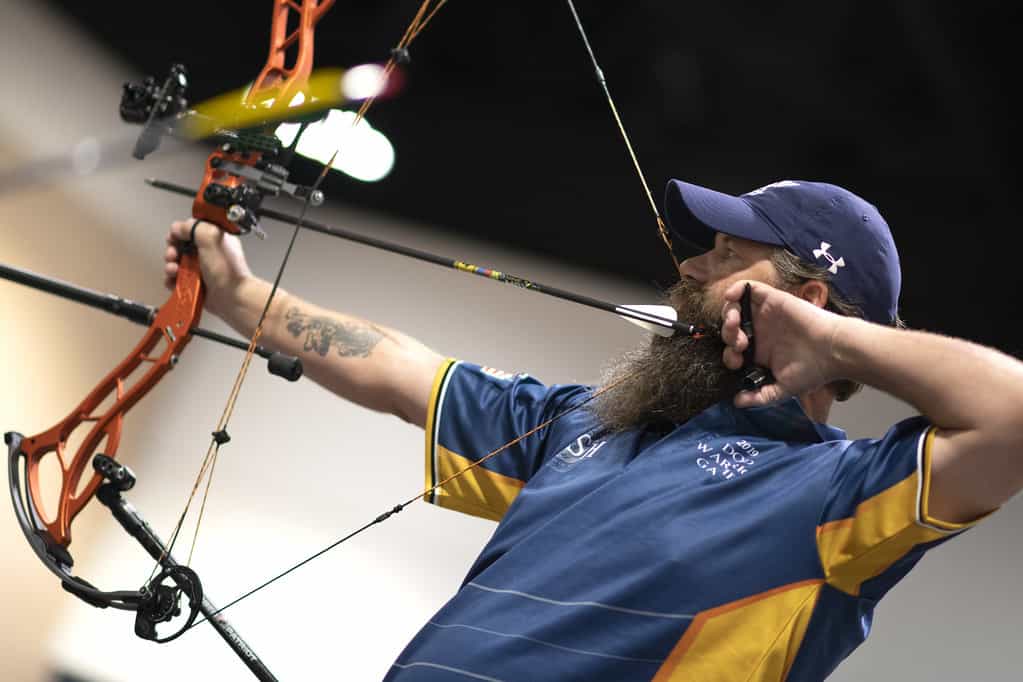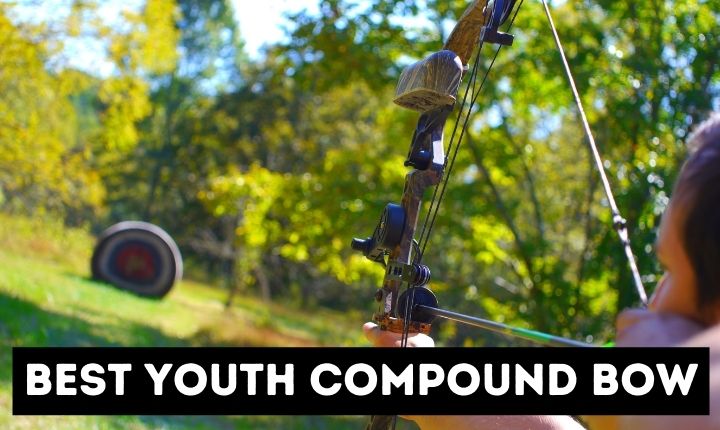The different parts of a compound bow include the riser, limbs, cams, strings, cables, grip, arrow rest, sight, stabilizer, quiver, peep sight, d-loop, limb pocket, limb bolts, cable guard, cable slide, idler wheel, cam track, limb dampeners, and string silencers. A compound bow is a modern bow that utilizes a system of pulleys and cables to generate high arrow velocities and increased accuracy.
It consists of various components that work together to provide a powerful and efficient shooting experience. From the main body of the bow, which is the riser, to the accessories like the sight and stabilizer, each part serves a specific function in contributing to the overall performance of the compound bow.
By understanding the different parts, archers can make adjustments and modifications to optimize their shooting. Whether for hunting or target shooting, a well-maintained and properly assembled compound bow is crucial for success.

Credit: cbayou.org
Understanding The Riser
The grip of a compound bow is an essential component that helps maintain a stable hold. It ensures a consistent shooting experience by providing a comfortable and secure grip. Another crucial part is the sight window, which allows archers to align their sight pins accurately with the target.
The sight window plays a vital role in achieving precise and consistent aim. And let’s not forget the quiver mount, which is used to attach a quiver for easy access to arrows during shooting. The quiver mount is usually located on the side of the riser, allowing archers to keep their arrows within reach.
Understanding these parts of a compound bow is crucial for mastering the art of archery.
Analyzing The Limbs
Analyzing the limbs of a compound bow is essential for understanding its structure. The upper limb plays a crucial role in drawing the bowstring, while the lower limb provides stability and balance. The limb bolt is responsible for adjusting the bow’s draw weight, allowing for customization and personalized shooting experience.
The limb pocket acts as a connection between the limbs and the riser, ensuring a secure and stable setup. Each of these components contributes to the overall performance and functionality of the compound bow. By comprehending the intricate details of the limbs, archers can make informed decisions when selecting or modifying their equipment.
Whether you are a professional or a beginner, understanding these different parts will enhance your overall shooting experience.
Exploring The Cam System
Exploring the cam system is a fascinating aspect of understanding compound bows. The cam, idler wheel, cam axle, and bowstring each play a crucial role in the bow’s function. The cam is the heart of the system, controlling the bow’s draw length and force.
The idler wheel maintains the bowstring’s tension throughout the draw. The cam axle supports the cam, allowing it to rotate smoothly. Lastly, the bowstring connects to the cam, transferring the energy to propel the arrow forward. It’s intriguing to see how these components work in harmony to provide accuracy and power.
Whether you’re a seasoned archer or a beginner, appreciating the complexity of a compound bow’s cam system adds depth to your understanding and improves your skills on the field.
Examining The Bowstring
Bowstring examination includes analyzing the string nock, serving, center serving, and peep sight. The string nock is the groove where the arrow is placed, while the serving is the protective layer around the bowstring. The center serving is a thicker section of serving positioned in the middle of the bowstring.
It helps protect the bowstring from damage caused by the arrow rest and serves as an anchor point for attachments. The peep sight is a small circular tube installed in the bowstring, allowing the archer to look through and aim accurately.
Examining these parts is crucial to ensure proper functionality and performance of the compound bow.
Evaluating The Cables And Cable Guard
Evaluating the cables and cable guard of a compound bow is crucial for optimal performance. The control cable, buss cable, and cable guard each play a significant role in ensuring accuracy and stability. The control cable assists in controlling the bow’s cam timing and synchronization.
It connects the top and bottom cams to regulate their movement. The buss cable, on the other hand, connects the opposite cam to the limbs and supports the bow’s draw weight. Lastly, the cable guard maintains the cables’ position during the draw cycle, preventing them from interfering with the arrow’s path.
By carefully evaluating and maintaining these components, archers can ensure their compound bow functions at its best, delivering accurate and powerful shots. Regular inspections and adjustments will keep the cables and cable guard in optimal condition, enhancing overall bow performance.
Investigating The Cams
Investigating the cams is crucial when it comes to understanding the different parts of a compound bow. The single cam is a common type, providing accuracy and smoothness. Hybrid cams combine the benefits of single cams and cam-and-a-half systems. Binary cams work in synchronization for enhanced accuracy.
Twin cams are another popular option, offering a balance between speed and accuracy. Each cam type has its own advantages, making it crucial to choose the right one based on your specific needs. When selecting a compound bow, consider the type of cam that will work best for your shooting style and preferences.
This understanding will help you optimize your compound bow experience and achieve maximum performance on the archery range or in the field.
Unveiling The Stabilizer
A compound bow consists of various components, and the stabilizer plays a significant role in its functionality. The main stabilizer, as the name suggests, helps in stabilizing the bow during the shooting process. It reduces vibrations and enhances accuracy by providing balance.
On the other hand, the side stabilizer, located at the front of the bow, also aids in minimizing movement and offers stability. Both stabilizers work together to ensure a smooth and controlled release of the arrow, resulting in improved aim and shot.
Understanding these components is crucial for archers looking to optimize their performance with the compound bow. By comprehending the role of the stabilizers, one can make necessary adjustments and modifications to achieve better accuracy and precision in their shooting.
Unmasking The Rest
When it comes to compound bows, understanding the different parts is crucial for archers. One such component is the arrow rest, which plays a vital role in accuracy and precision. It serves as a platform for the arrow to rest on before release, ensuring a clean and smooth shot.
Arrow rests are available in various types, including capture rests, drop-away rests, and shoot-through rests. Each type has its own benefits and considerations, catering to different shooting styles and preferences. These rests are designed to properly support the arrow and reduce any unwanted contact or interference, resulting in improved arrow flight and minimized noise.
Archer’s choice of arrow rest is often based on their specific needs and shooting techniques. By understanding the functionality and purpose of the arrow rest, archers can enhance their shooting experience and achieve consistent and accurate shots.
Revealing The Sight
A pin sight is one of the most essential parts of a compound bow, allowing the archer to aim accurately. The pin sight consists of multiple pins that help in aligning the target. Each pin corresponds to a specific distance, and the archer can adjust them accordingly.
The pin sight is adjustable and can be moved up or down, left or right. This feature enables the archer to compensate for various shooting conditions and distances. It is crucial to choose the correct pin sight for your compound bow, as it plays a vital role in precision and accuracy.
A well-calibrated and properly set pin sight is essential for consistent and successful shooting experiences. It is worth investing time and effort into understanding and mastering this crucial component of your compound bow setup.
Shedding Light On The D-Loop
A crucial component of a compound bow is the d-loop, which plays a significant role in the bow’s string. The d-loop is a small piece of material installed on the bowstring, forming a loop. It serves as an attachment point for the release aid, facilitating a consistent and smooth release.
Made from durable materials like nylon or polyester, the d-loop endures the constant pressure from the release aid and the force exerted by the bowstring during each shot. The loop’s size is important, as it affects the accuracy and precision of the shot.
A properly installed and adjusted d-loop ensures a secure connection with the release aid, resulting in a more controlled arrow release. Archers often customize the d-loop’s length and positioning to suit their shooting style, providing a personalized experience with their compound bow.
Understanding the role of the d-loop is essential for archers of all levels to optimize their performance.
Nocking Point And Nocking Loop
A compound bow consists of various parts, each serving a specific purpose. One of these components is the nocking point. The nocking point is the area where an arrow is placed on the bowstring before shooting. It is crucial for the arrow to be properly aligned with the bow to ensure accuracy.
Another important element is the nocking loop, which is a small, usually plastic, attachment placed on the bowstring. This loop helps hold the arrow securely in place during the draw and release. These two components work together to ensure smooth and precise shooting with a compound bow.
Understanding their functions and proper placement is essential for archers looking to improve their performance.
Understanding The Cams And Modules
A compound bow consists of various parts, each playing a crucial role in its function. One important component is the cam and module system, which aids in the bow’s mechanical advantage. Cam modules are key elements that affect draw length and allow for adjustability.
These modules are often interchangeable, allowing archers to customize their bow to fit their needs. Understanding the cams and modules is essential for optimizing performance and achieving accuracy when using a compound bow. By familiarizing yourself with these components, you can fine-tune your bow for optimal shooting experience and consistent results.
Whether you are a beginner or an experienced archer, grasping the intricacies of the cam and module system will enhance your overall shooting skills. Take the time to learn and appreciate the mechanics behind these vital components in your compound bow setup.
Insight Into The String Stop And Silencers
Insight into the string stop and silencers the string stop is a crucial part of a compound bow. It reduces vibration and noise during shooting. Silencers also play a significant role in minimizing noise. By strategically placing them on the bowstring, the sound produced upon release is muffled.
Both the string stop and silencers contribute to a quieter shot. Moreover, they enhance shooting accuracy by reducing bowstring movement and oscillation. When the string stop absorbs the energy from the string, it aids in reducing hand shock. On the other hand, the silencers dampen any residual vibrations.
Therefore, these two components are essential in creating a more enjoyable shooting experience. Whether you are a pro or a beginner, these features can greatly enhance your archery performance. So, make sure to pay attention to the string stop and silencers on your compound bow.
Examining The Peep Sight
Examining the peep sight on a compound bow involves understanding the role of peep sight tubing. The peep sight tubing serves as a connection between the peep sight and the bowstring. It ensures that the peep sight stays in position and aligns with the shooter’s eye when aiming.
Made of flexible and durable materials, such as rubber or silicone, this tubing provides stability and reduces vibrations. Proper installation and adjustment of the peep sight tubing are crucial for consistent accuracy. Choosing the right size and tension ensures a secure fit and allows for easy adjustments if needed.
Regular inspection and maintenance of the tubing can prevent wear and tear, guaranteeing optimal performance during shooting sessions. Understanding the importance of peep sight tubing contributes to overall proficiency in using a compound bow.
Focusing On The Cable Slide
A crucial component of a compound bow is the cable slide. This mechanism ensures smooth movement of the cables and reduces noise during shooting. The cable slide, located just above the grip, plays a vital role in the overall performance of the bow.
It keeps the cables separated, ensuring that they do not interfere with each other or the bowstring. This separation is crucial for accurate arrow flight and for preventing string wear. The cable slide is typically made of durable materials like aluminum or plastic, and it should be regularly inspected for any signs of wear or damage.
Taking proper care of the cable slide will help maintain the bow’s performance and ensure a successful shooting experience.
Exploring The String Silencers
A compound bow consists of various components that work together to provide accuracy and power. One essential part of a compound bow is string silencers. String silencers are designed to reduce noise and vibrations produced when releasing an arrow. These small accessories are usually made from rubber or silicone and are installed on the bowstring.
When the bow is drawn and released, the string silencers dampen the vibrations, resulting in a quieter shot. By reducing noise, string silencers help hunters remain undetected in the field, increasing their chances of a successful hunt. Additionally, string silencers can also contribute to improving accuracy by minimizing string oscillation and stabilizing the bow during the shot.
Overall, string silencers play a crucial role in enhancing the performance and effectiveness of a compound bow.
Uncovering The Cable Guard Slide
The cable guard slide is one of the essential parts of a compound bow. It plays a crucial role in guiding the cables and ensuring smooth arrow release. Positioned on the bow riser, it facilitates cable movement during the draw cycle.
Made from durable materials like aluminum or carbon fiber, the cable guard slide is designed to reduce friction and maintain accuracy. Its adjustable nature allows archers to fine-tune the cable position for optimal performance. Understanding the cable guard slide’s function and proper maintenance is vital for bow enthusiasts.
Regular inspection, cleaning, and lubrication can help extend its lifespan and prevent any potential issues during shooting. So, whether you are a beginner or an experienced archer, familiarizing yourself with the cable guard slide is essential for a successful bowhunting or target shooting experience.
Assessing The Stabilizer Dampener
Assessing the stabilizer dampener is a crucial step when it comes to understanding the parts of a compound bow. This component plays a significant role in minimizing vibrations and enhancing accuracy. By effectively absorbing shock, the stabilizer dampener ensures a smooth and steady shot.
It is typically located at the end of the bow, opposite to the grip. Properly assessing the stabilizer dampener involves inspecting its length, weight, and material composition. Different bows may require specific stabilizer dampeners based on their design and shooting style.
It is important to choose a dampener that suits your needs and preferences, as it can significantly impact your shooting experience. By properly evaluating the stabilizer dampener, you can optimize your bow’s performance for increased precision and stability.
Scrutinizing The Quiver
A critical aspect of a compound bow is the quiver, designed to hold the arrows securely. Typically made of durable materials such as plastic or fabric, the quiver attaches to the bow, allowing quick access to arrows during archery. There are various types of quivers available, including hip quivers, back quivers, and bow quivers.
Hip quivers are commonly worn on the shooter’s belt, providing easy access to arrows. On the other hand, back quivers are slung over the shoulder or carried on the back, offering convenience for the archer. Bow quivers, the third type, attach directly to the bow, eliminating the additional burden of a separate quiver.
Whether you’re a beginner or a seasoned archer, choosing the right quiver is crucial for a smooth and efficient shooting experience.
Understanding The Sling
Understanding the sling of a compound bow is vital for archers. The sling, sometimes called a wrist sling, is an accessory that wraps around the wrist and attaches to the bow riser. Its purpose is to prevent the bow from dropping when the archer releases the string.
A well-designed sling provides stability and consistency throughout the shooting process. While there are different types of slings available, they all serve the same fundamental purpose. Archers can customize their slings by selecting different materials, colors, and designs. Some archery enthusiasts even choose to make their own slings using paracord or other durable materials.
Proper utilization of a sling can greatly enhance accuracy and control while shooting a compound bow.
Frequently Asked Questions For 20 Different Parts Of A Compound Bow
What Are The Main Parts Of A Compound Bow?
The main parts of a compound bow include the riser, limbs, cams, string, arrow rest, sight, stabilizer, peep sight, and grip. These components work together to create an efficient and powerful weapon for hunting or target shooting.
What Is The Purpose Of The Riser In A Compound Bow?
The riser is the central part of a compound bow and houses the grip, arrow rest, and other essential components. It provides stability and balance to the bow, allowing for more accurate shots. The riser is typically made from lightweight and durable materials such as aluminum or carbon fiber.
How Do The Cams On A Compound Bow Work?
The cams on a compound bow are responsible for storing and releasing energy during the shooting process. As the bowstring is drawn back, the cams rotate, creating a let-off effect that reduces the amount of force required to hold the bow at full draw.
This makes it easier to aim and hold steady for longer periods.
Conclusion
As we wrap up our exploration of the different parts of a compound bow, it becomes clear that each component plays a crucial role in the overall performance and functionality of the bow. From the riser to the cams, each part must work in perfect harmony to ensure accuracy, power, and consistency.
Whether you are a seasoned archer or a beginner looking to dive into the world of archery, understanding these various parts will give you greater insight into how a compound bow operates. The importance of familiarizing yourself with the limbs, cables, and string cannot be understated, as they directly impact the energy transfer and speed of the arrow.
The grip and arrow rest aid in stability, while the sight, peep sight, and stabilizer enhance accuracy. Not forgetting the releases, dampeners, and quiver, which contribute to a more enjoyable shooting experience. By appreciating all 20 parts of a compound bow, archers can take their skills to new heights.
So, whether you’re a hunter, a target shooter, or simply enjoy this captivating sport, understanding the intricacies of a compound bow will surely enhance your archery journey.

General Manager & Auditorial Head.
Killian Jake is a World Sports Traveler and hobbyist sports lover. By exploring different sorts of playing modules like indoor, outdoor, and many more. As for professionalism and writing, it’s helpful to give you the right suggestions on different games and sports.





